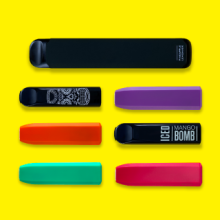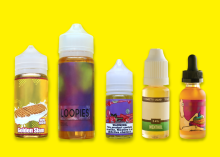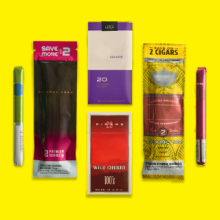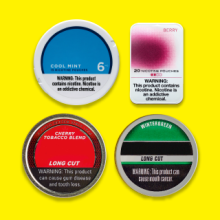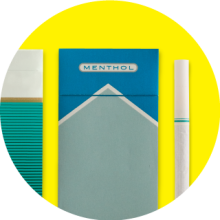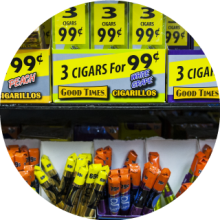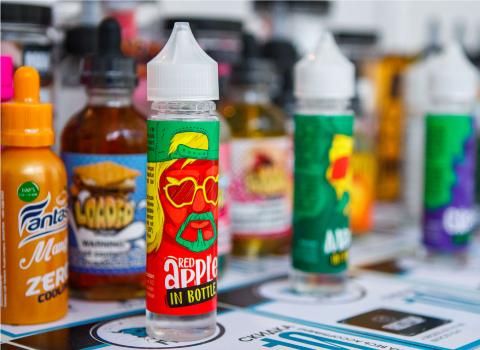Tobacco is Changing: Flavored Tobacco Products
Flavors Lure Young, First-time Tobacco Users
Grape, cherry, cotton candy, root beer float, sour apple. How much do sweet flavors like these matter to young people? A lot. In Wisconsin, 96% of middle schoolers say they probably wouldn't try an e-cigarette—the most popular tobacco product among youth today—if it wasn't flavored.
Once you realize most tobacco users start before they turn 18, it’s easy to understand why the tobacco industry works so hard to keep flavored cigars, e-cigarettes, and smokeless tobacco products on store shelves.
When flavored cigarettes were banned in the U.S. in 2009, flavored tobacco products quickly took on new shapes and styles, and after a federal, flavored e-cig restriction limited sweet candy flavors in certain kinds of e-cigarettes, in 2020, the popularity of alternatives like flavored disposable vapes and sweet e-cigarette juices, used in refillable devices, soared. Meanwhile, the use of menthol—a minty flavor that research shows makes tobacco products easier to start and harder to quit—hasn’t been restricted by the FDA.
That means there are still plenty of ways for Wisconsin’s kids to satisfy their sweet tooth—and start a lifelong addiction.
Still on the Shelves:
Menthol
Menthol’s cooling sensation and minty flavor make tobacco products easier to use and harder to quit. That’s a deadly combination in communities of color, where tobacco companies spend millions to keep African-American, menthol tobacco users hooked.
Flavored Disposables
Disposable e-cigarettes aren’t covered by the latest, flavored e-cigarette restrictions, so they still boast sweet candy flavors like watermelon, blue raspberry, and lemon dessert. They’re also cheap, widely available, and growing in popularity.
Flavored E-liquids
Untouched by the federal, flavored e-cigarettes ban, e-liquids and refillable flavor cartridges come in thousands of flavors, like graham cracker, popsicle, cherry limeade, and gummy bear.
Flavored Cigar Products
Cigars, little cigars, and cigarillos are made in a wide variety of sweet, fruity, and minty flavors. Sold singly, or in packs ranging from two to 20 cigars, young people can get a flavor fix for just a few dollars at most gas stations, convenience stores, and tobacco shops.
Flavored Smokeless Tobacco
Cigars, little cigars, and cigarillos, are made in a wide variety of sweet, fruity, and minty flavors. Sold singly, or in packs ranging from two to 20 cigars, young people can get a flavor fix for just a few dollars at most gas stations, convenience stores, and tobacco shops.
You Should Know
New flavored e-cigarette laws haven’t ended the youth vaping epidemic. The same sweet flavors that first drew young people to e-cigarettes are still available in products that bypass new federal restrictions, like disposable e-cigarettes, e-liquids, and refillable flavor cartridges.
Flavored tobacco products aren't a novelty. Some people think fruit, candy, and mint-flavored tobacco products aren't all that common, but that couldn't be further from the truth. At least 40% of cigarillos, and smokeless products, are flavored and there are at least 15,500 uniquely flavored e-cigarette liquids on the market.
A kid's first tobacco product is usually flavored. Flavored tobacco products are often the very first tobacco product a young person tries. That's true for at least 80% of kids who've used tobacco, and two out of three young tobacco users say they use tobacco products because "they come in flavors I like."
Flavored products are not safe products. Candy flavors like strawberry, fresh mint, and cotton candy can give the impression that flavored e-cigarettes, little cigars, cigarillos, and smokeless products are safer or milder versions of conventional tobacco, but no tobacco product is safe. Sweet and minty flavors merely mask tobacco's chemicals and harsh taste,
Raising the legal age for purchasing tobacco to 21 is an important step for preventing youth tobacco use, but not every law is as helpful. Right now, the tobacco industry is taking advantage of 2020 federal, flavored e-cigarette restrictions that only impact a few, specific devices. The result? Flavors that target youth, like cotton candy, menthol, and gummy bear, are still on the market, tempting kids to try tobacco products that are already too easy for young people to access and afford.
Wisconsin needs comprehensive tobacco policies that work together to prevent youth tobacco use. You can help make it happen, by supporting legislation that restricts the sale of all flavored tobacco products, including menthol, as part of Wisconsin’s tobacco prevention efforts.
Resources
Learn more about flavors and the harm they can do:
Vape Products Still Allowed Under the Federal Flavor Restrictions
Flavored Tobacco
Flavored Tobacco Products Attract Kids
2018 Wisconsin Youth Tobacco Survey—Middle School, P-01624a
Know the Risks: E-Cigarettes and Young People
The Flavor Trap
Different Tactics, Same Threat
Understand all the ways tobacco companies scheme to make, package, and market products that can lock down the next generation of lifelong tobacco users.
Support Comprehensive Flavor Restrictions
To protect young people, federal, flavored e-cigarette regulations should cover all electronic smoking devices, including: disposable e-cigarette and flavored e-liquids, refills, and cartridges. You can help make that happen. Find out how you can support comprehensive tobacco policies for a healthier state and take action in your own community.
Take the Next Step
Change for the better starts when caring individuals stand together for kids, their communities, and policies that can improve everyone’s health. Find out how you can make a difference.




